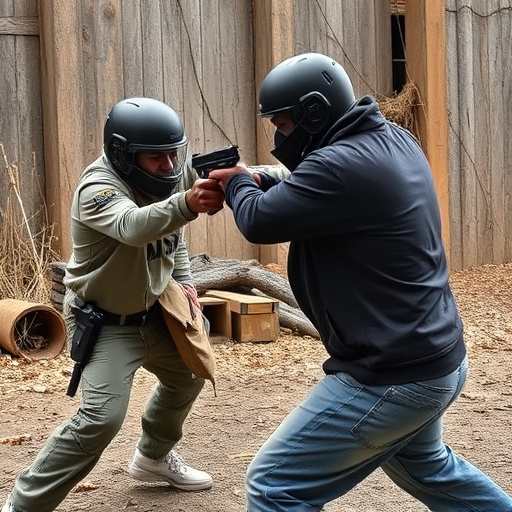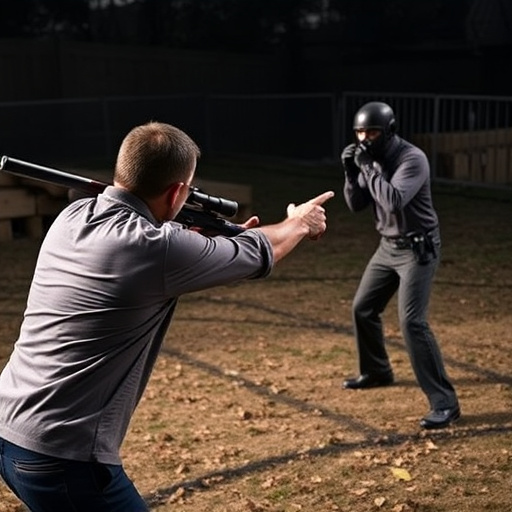Voltage Through Clothing: Safety Insights for Runners with Compact Stun Guns
TL;DR: Compact stun guns, designed for runners' safety, depend on voltage interaction with clot…….
TL;DR: Compact stun guns, designed for runners' safety, depend on voltage interaction with clothing. Thicker fabrics block more voltage, while thinner materials permit higher conductivity. Runners should consider clothing choices, balancing breathability and protection. The thickness of materials significantly affects electricity flow, impacting stun gun effectiveness. These devices offer lightweight self-defense, delivering powerful electric shocks to disable attackers at close range or through clothing. For optimal use, carry the stun gun in reach and aim for the center of mass, with regular training essential for safe deployment.
In today’s world, understanding how voltage traverses thick clothing is paramount, especially for outdoor enthusiasts and runners. This article delves into the science behind electricity’s path through fabrics, focusing on its effects and the role of material thickness. We explore compact stun guns as a runner’s safety companion, dissecting their operation and penetration capabilities. Key factors influencing voltage transfer through textiles are examined, along with best practices for emergency situations, providing essential knowledge for personal security.
- Understanding Voltage and Its Effects on Clothing
- The Role of Material Thickness in Electricity Flow
- Compact Stun Guns: A Runner's Safety Companion
- How Stun Guns Work and Their Penetration Capabilities
- Factors Influencing Voltage Transfer Through Textiles
- Best Practices for Using a Stun Gun in Emergency Situations
Understanding Voltage and Its Effects on Clothing

Voltage, a measure of electrical potential difference, is as crucial as it is formidable. When we discuss its penetration through clothing, understanding its behavior becomes essential for safety, especially when considering compact stun guns designed for runners’ personal safety. The effects of voltage on fabric can range from no perceptible impact to significant damage, depending on factors like current strength, duration, and the type of clothing material.
Clothing acts as a barrier, but its thickness and composition play a pivotal role in how much voltage passes through. Thicker fabrics generally offer more protection due to their density, while thinner materials allow for greater conductivity. A compact stun gun’s effectiveness against an assailant is thus influenced by the wearer’s clothing choices—a light, breathable outfit might not provide adequate defense against a high-voltage charge compared to a thicker, insulated layer.
The Role of Material Thickness in Electricity Flow

The thickness of a material plays a pivotal role in determining how effectively electricity can pass through it. When considering a scenario where a compact stun gun for runners’ safety is concerned, understanding this dynamic becomes crucial. Thicker fabrics or materials create a higher resistance to electrical current flow due to their dense structure. This natural barrier effect slows down the rapid movement of electrons, making it more challenging for electricity to penetrate deeply.
For instance, a thin layer of cotton clothing might allow an electric charge to pass through relatively unhindered, whereas a thick woolen jacket would significantly impede its progress. This principle is essential when designing protective gear or understanding how certain materials can interfere with the effectiveness of small, compact self-defense devices like stun guns. The ability of these devices to deliver a powerful shock depends on the ease with which electrical energy flows through the wearer’s clothing.
Compact Stun Guns: A Runner's Safety Companion

Compact stun guns are an excellent option for runners seeking personal safety while on their daily jogs. Their small size and lightweight design make them easy to carry, allowing runners to have a means of protection in case of unexpected encounters or emergencies. These stun devices deliver a powerful electric shock, temporarily incapacitating an assailant, giving the user valuable time to escape and seek help.
For runners who frequently exercise in remote areas or places with low lighting, a compact stun gun can be a life-saver. Its ease of use means that even without martial arts training, anyone can deploy it effectively. With just a simple press of a button, the stun gun releases an electric current, ensuring the user’s safety and peace of mind during their runs.
How Stun Guns Work and Their Penetration Capabilities

Stun guns, also known as electroshock weapons, operate by delivering a powerful electric shock to incapacitate a target. They are designed to be compact and easily portable, making them an attractive option for personal safety, especially for runners who need quick protection in potentially dangerous situations. The mechanism involves firing a low-voltage, high-current electrical pulse through two electrodes, which can temporarily disrupt the target’s muscular control, leading to loss of balance or even temporary paralysis.
The penetration capabilities of stun guns are influenced by several factors, including voltage, current, and the distance between the device and the target. While they are most effective for close-range use, modern compact stun guns can penetrate through various materials, such as clothing, to deliver a shock. This feature makes them versatile tools for self-defense in situations where a potential attacker is wearing protective gear or layers of clothing, providing runners with an additional layer of safety and peace of mind.
Factors Influencing Voltage Transfer Through Textiles

The voltage penetration through thick clothing is influenced by several factors, which can significantly impact the effectiveness of a compact stun gun for runner’s safety. The first factor is the type and thickness of the fabric. Different textiles have varying electrical properties, with conductive materials like metal or certain synthetic fibers allowing for easier current flow. Thicker fabrics create a higher resistance to electric charge transmission, making it harder for voltage to pass through.
Another crucial element is moisture content in the clothing. Moisture can conduct electricity, enhancing voltage transfer. Therefore, wet or damp textiles may contribute to better penetration than dry ones. Additionally, the presence of metal components or accessories attached to an individual’s clothing can also affect how much voltage is conducted, potentially increasing its effectiveness for self-defense purposes when equipped with a compact stun gun designed for runners’ safety.
Best Practices for Using a Stun Gun in Emergency Situations

In emergency situations, a compact stun gun can be a powerful tool for self-defense, especially for runners and outdoor enthusiasts who face unpredictable risks. The best practice is to carry it in an easily accessible location, such as a belt pouch or armband, ensuring quick retrieval when needed. A small, lightweight design allows for discreet carrying without compromising mobility.
When using a stun gun, remember to aim for the center of mass, typically the groin or chest area, for maximum effectiveness and safety. It’s crucial to understand the range limitations; while some models claim long-range stun capabilities, close contact (typically 2–3 feet) is often required for successful deployment. Regular training and familiarization with the device are essential to ensure its effective use when facing an emergency.
In understanding voltage penetration through thick clothing, it’s clear that a compact stun gun offers a powerful tool for personal safety, especially for runners. These devices leverage advanced technology to ensure swift and effective protection, with their ability to penetrate fabrics providing a critical layer of defense against potential threats. By adhering to best practices, users can maximize the impact of these tools, making them indispensable companions on even the busiest urban trails. The compact stun gun for runner’s safety is not just an option; it’s a responsible choice in today’s world.


